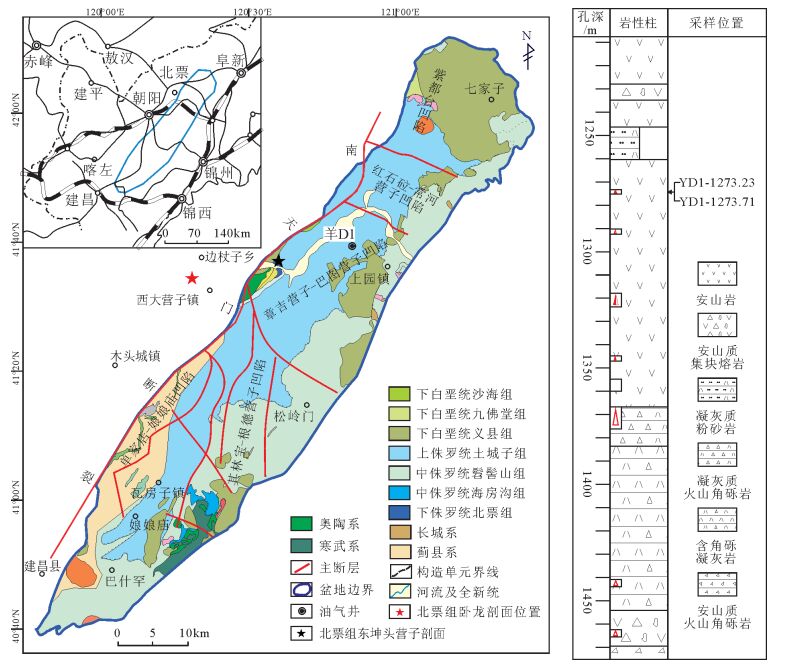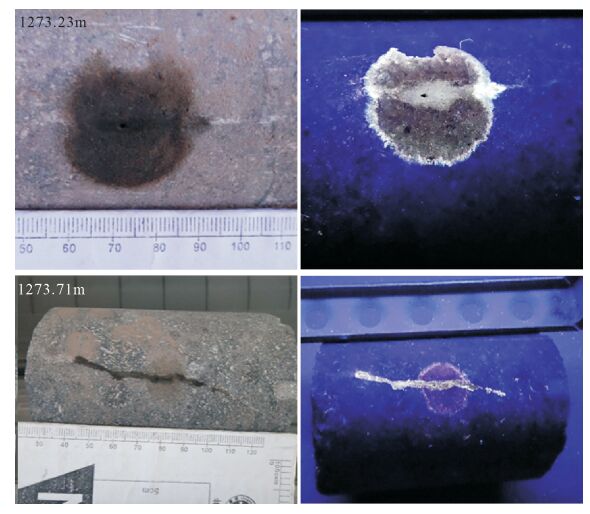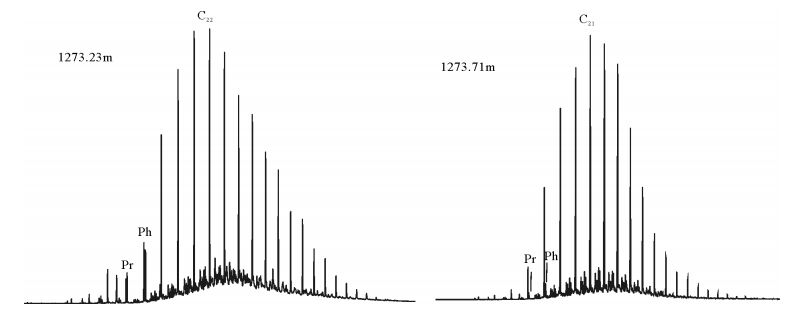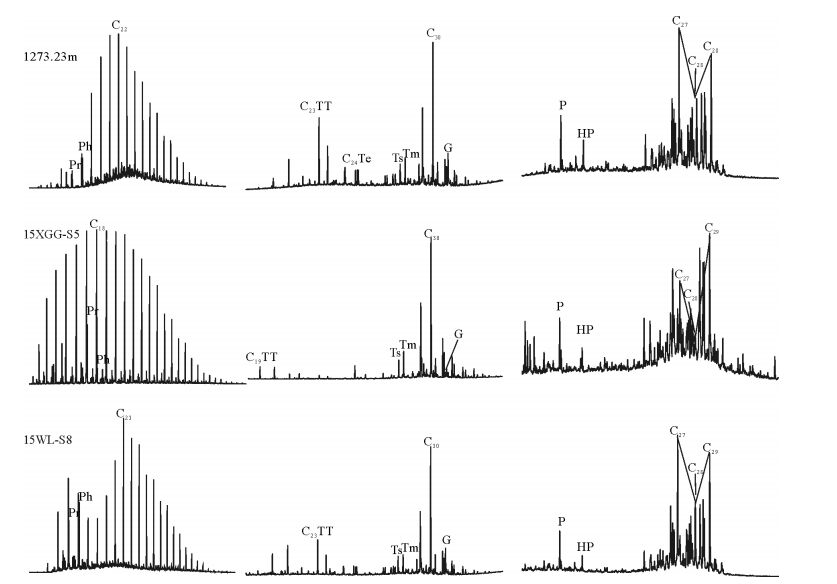Saturated hydrocarbon geochemical characteristics of the oil sand from YD1 well in Jinyang Basin and its significance for oil and gas exploration
-
摘要:
在中国地质调查局沈阳地质调查中心实施的“羊D1”井的中侏罗统髫髻山组火山岩中见多处油气显示,取得了油气新发现。对该井已发现的2件油砂样品中的原油采用气相色谱-质谱技术(GC-MS)进行了分析测试,结果显示,2个油砂样品的地球化学特征一致,表现为链烷烃呈现出单峰态的分布,主峰碳数分别为C21和C22,无明显奇碳数优势,姥植比值低;萜类化合物表现为,三环萜烷以C23为主峰呈正态分布,C24四环萜烷与C26三环萜烷丰度相当,伽马蜡烷含量较高;甾类化合物表现为规则甾烷相对含量关系为C27 > C29 > C28,以C27甾烷占优势的不对称“V”形分布。这些指标总体指示,原油为成熟油,对应烃源岩沉积于偏还原性的湖相环境,母质来源主要为藻类等低等水生生物,陆源高等植物也具有一定贡献。通过和周边的北票组烃源岩进行油岩对比研究发现,油砂样品中的原油可能来自于盆地内下伏的下侏罗统北票组烃源岩的贡献。研究结果说明,北票组在金羊盆地分布广泛,其烃源岩可能具有较好的生油潜力,金羊盆地是一个具有勘探潜力的含油气盆地。
Abstract:Recently researchers from Shenyang Geological Survey of CGS made several new discoveries in geological well YD1 in Jinglingsi-Yangshan basin (Jinyang Basin). During the drilling of YD1 the authors detected several oil and gas showings in the fractures of the drilling core in Mid-Jurassic Tiaojishan Formation (J2t) which was mainly composed of intermediate igneous rocks. The characteristics of biomarkers from YD1 oil sand were analyzed by the method of gas chromatography and gas chromatography mass spectrometry (GC, GC-MS). The results show that the two oil sand samples have similar geochemical characteristics:the n-alkane distribution exhibits one sole peak pattern, and the dominant peaks are nC21 and nC22 separately; there is no clear odd or even carbon number predominance for the n-alkanes, and thus the carbon preference index (CPI) is only slightly higher than 1; the samples have low Pr/Ph ratios. The terpene is characterized by the normal distribution of C23 tricyclic terpene and similar abundance of C24 tetracy-clic terpene and C26 tricyclic terpene, with a relatively abundant value of gammacerane. The regular steranes are dominated by the C27-steranes, and their relative abundance is in the order of C27 > C29 > C28, exhibiting the "V" distribution pattern. These biomarkers' characteristics indicate that the source rocks are matured and predominated mainly by planktonic/algal organic matter. The source rocks were deposited in a lacustrine environment with a high-salinity stratified water column and anoxic conditions. The oil-source correlation results showed that the crude oil from the samples was possibly derived from the source rock in Early Jurassic Beipiao Formation (J1b). The results indicate that the source rock from Beipiao Formation is widely spread in Jinyang Basin and has good oil and gas potential, and hence Jinyang Basin is a petroliferous basin with good potential for oil and gas exploration.
-
Keywords:
- Jinyang Basin /
- YD1 well /
- oil sand /
- biomarker /
- oil-source rock correlation
-
安徽滁州地区探明的铜、金矿床(点)较多,典型的有上成金矿、郭大洼金矿、马厂金矿、大庙山金矿、铜苟城金矿、琅琊山铜矿等,地质学和年代学研究表明,这些矿床在空间和时间上与早白垩世岩体有关[1-2],地球化学研究进一步显示这些岩体具有埃达克质岩石的特征,并与长江中下游含矿埃达克岩特征类似[2]。目前国内学者对埃达克质岩成因的认识仍存在分歧[3-27]。比如,埃达克质岩的形成可能来自地壳混染的玄武岩浆结晶分异作用[5, 16-17, 20];或是幔源岩浆和壳源岩浆的混合,并可能有来自古太平洋板块俯冲带来的混入端元成分的参与[25-26];再或者是俯冲洋壳的部分熔融[18-22, 27];依据比俯冲洋壳高的87Sr/86Sr值和低的143Nd/144Nd值,一些学者认为,埃达克质岩由拆沉或加厚古老下陆壳部分熔融而成[3-4, 6-15]。尽管关于埃达克质岩的成因存在不同认识,但是世界上大部分著名的铜-金矿床都与埃达克(质)岩有关[28-33],且埃达克岩或埃达克质岩对陆壳的演化、地幔橄榄岩的交代作用[28]也有潜在的重要性,因此,本文通对安徽滁州张八岭地区闪长质岩锆石U-Pb年代学和岩石地球化学特征的详细研究,提供研究区闪长质岩的准确年龄数据,分析其岩石成因,初步讨论动力学背景及其与铜、金等的成矿关系,更好地为该区铜、金多金属矿提供找矿依据。
1. 区域地质背景
研究区大地构造位置处于张八岭隆起构造带与扬子前陆褶冲带结合部位,经过多次构造变形,断裂构造发育,主要断裂为近南北向管店-马厂断裂和北东向黄栗树-庙集断裂,北部张八岭隆起构造带出露的主要地层为新元古代北将军组和西冷岩组,北将军组主要为千枚岩为主的副变质岩系;西冷岩组主要为变细碧-角斑岩夹变粉砂岩,岩石类型包括绢云千枚岩、石英绢云千枚岩、绢云石英片岩、含云母石英片岩等。东南部扬子前陆褶冲带主要出露震旦系—奥陶系。下震旦统岩性主要为砂岩、粉砂岩、粉砂质千枚岩,上震旦统岩性主要为灰岩夹砂岩、砂质千枚岩;寒武系主要岩性为碳酸盐岩,下部见炭质页岩、硅质页岩夹石煤层;奥陶系主要岩性为灰岩、大理岩。研究区岩浆活动较强烈,有管店岩体、瓦屋刘岩体、瓦屋薛岩体、马厂岩体及广泛分布的中酸性脉岩(图 1)。
2. 岩相学特征和样品描述
本次采集了安徽滁州地区张八岭隆起区和扬子前陆带出露的管店岩体、马厂岩体及马厂地区出露的脉岩。马厂岩体及马厂地区出露的脉岩(图版Ⅰ-a)呈北东向展布,本次以马厂闪长玢岩为定年及岩石地球化学研究对象。岩石主要矿物成分为斜长石和角闪石,同成分组成斑晶和基质,基质具显微晶质结构。斜长石斑晶呈板柱状,均径为1.00~2.00mm,最大2.50mm,常见环带结构,为更-中长石,有绢云母化。角闪石斑晶为柱状,横切面为菱形,见解理,均径为1.00~1.50mm,有绿泥石化、绿帘石化,一般为普通角闪石。基质为同成分显微晶质结构,分布较均匀(图版Ⅰ-c、d)。
管店岩体呈北北东向展布,主要岩性包括石英二长岩、二长岩、黑云母花岗岩、花岗闪长岩、闪长玢岩及细晶闪长岩,采集了管店岩体北部的闪长玢岩脉及细晶闪长岩(图版Ⅰ-b)作为岩石地球化学研究对象,闪长玢岩主要矿物成分为斜长石和角闪石,其次为黑云母、钾长石,含少量石英。斜长石为板柱状,斑晶最大9mm,基质斜长石一般为1.50~2.00mm,双晶纹较对称,偶见环带结构,为中长石。钾长石为他形粒状,有高岭土化,为正长石。石英呈填隙状,含量很少。角闪石呈浅绿色,半自形,为普通角闪石,有绿泥石化,析出磁铁矿和榍石。细晶闪长岩主要矿物成分为斜长石和角闪石,含少量磁铁矿。斜长石为柱状,聚片双晶较对称,偶见环带结构,以中长石为主,有绢云母化、钠长石化。角闪石为浅黄绿色,绿泥石化、绿帘石化明显,析出的磁铁矿分布于表面(图版Ⅰ-e、f)。
3. 分析方法
3.1 LA-ICP-MS锆石U-Th-Pb同位素
原岩样品破碎成粉末,经淘洗和磁选分离出锆石重砂样,在双目镜下挑选出锆石晶体,将待测锆石颗粒制成环氧树脂样品靶,打磨至大部分颗粒的中心暴露出来,用于拍摄透射光和反射光、阴极发光(CL)图像及U-Th-Pb同位素测试。LA-MCICP-MS锆石U-Th-Pb同位素测试在中国地质科学院矿产资源研究所MC-ICP-MS实验室完成,所用仪器为Finnigan Neptune型MC-ICP-MS及与之配套的Newwave UP 213激光剥蚀系统。激光剥蚀斑束直径为25μm,频率为10Hz,能量密度约为2.5J/cm2,以氦为载气。LA-MC-ICP-MS激光剥蚀采样采用单点剥蚀的方式,数据分析前用锆石GJ-1进行调试仪器,使之达到最优状态,锆石U-Pb定年以锆石GJ1为外标,U、Th含量以锆石M257为外标进行校正。测试过程中每测定10个样品前后重复测定2个锆石标准,对样品进行校正,并测量1个锆石标准Plesovice,观察仪器的状态以保证测试的精确度。数据处理采用ICPMSData⁃ Cal程序[34],测量过程中绝大多数分析点206Pb/204Pb>1000,未进行普通铅校正,204Pb由离子计数器检测,剔除可能受包体等普通Pb的影响204Pb含量异常高的分析点,锆石U-Pb谐和图用Isoplot 3.0程序获得。
3.2 岩石地球化学
本次工作全岩主量和微量元素分析在广州澳实矿物实验室完成。主量元素分析采用X-射线荧光光谱分析法(XRF法),首先称取0.6g干燥粉末样品,在高温条件下加热,除去挥发分并计算烧失量(LOI),然后加入适量的硼酸将样品高温熔融成玻璃片,然后在X-射线荧光光谱仪上测定氧化物的含量,分析精度优于5%。微量元素采用ICPMS(电感耦合等离子体质谱)分析方法。将约40mg样品酸溶(对中酸性岩)或碱溶(对基性岩)后测定微量元素的浓度,大部分元素的分析精度优于2%。
4. 分析结果
4.1 锆石U-Th-Pb同位素
安徽滁州地区闪长质岩中2个闪长玢岩定年样品的LA-ICP-MS锆石U-Pb年龄数据列于表 1,锆石CL图像见图 2。大部分锆石是无色、透明的,半自形到自形,具有典型的岩浆成因锆石生长环带。Th和U含量变化范围较大(Th为2×10-6~719×10-6,U为46×10-6~531×10-6),Th/U值变化范围为0.24~ 2.42,绝大多数大于0.1,与岩浆成因锆石一致。样品160309-1共获得23个点的年龄,其中14个点的206Pb/238U年龄集中在124~129Ma之间,其年龄加权平均值为126.2±0.44Ma(MSWD=6.9),代表岩体的形成年龄(图 3);另外7个点的207Pb/206Pb年龄介于1976~2657Ma之间,锆石具有岩浆环带,且Th/U值大于0.1,也属于岩浆成因锆石,代表古元古代—太古宙继承锆石年龄。160309-2共测得19个点的年龄,年龄可分为2组,其中7个点的206Pb/238U年龄介于126~130Ma之间,给出的206Pb/238U年龄加权平均值为126.4±0.7Ma(MSWD=8.8),代表岩体的形成年龄;其余12个点的207Pb/206Pb年龄集中在2013~ 2569Ma之间,是继承锆石的年龄,其中2480~ 2569Ma之间8个点的207Pb/206Pb年龄加权平均值为2505±19Ma(图 3)。
表 1 LA-ICP-MS锆石U-Th-Pb同位素测定结果Table 1. Results of the LA-ICP-MS zircon U-Th-Pb dating样品 含量/10-6 Th/U 207Pb/206Pb 206Pb/238U 207Pb/206Pb 206Pb/238U Pb 232Th 238U 比值 1σ 比值 1σ 年龄/Ma 1σ 年龄/Ma 1σ 160309-1-1 13 350 576 0.61 0.0517 0.0019 0.0194 0.0002 272 92 124 2 160309-1-2 190 14 459 0.03 0.1638 0.0013 0.3711 0.0037 2415 186 2035 18 160309-1-3 7 180 273 0.66 0.0524 0.0021 0.0201 0.0002 128 103 128 2 160309-1-5 8 293 313 0.94 0.0514 0.0022 0.0212 0.0003 209 90 128 2 160309-1-6 115 96 228 0.42 0.1594 0.0015 0.4145 0.0029 2368 16 2234 13 160309-1-7 11 377 367 1.03 0.0545 0.0028 0.0224 0.0003 276 122 141 2 160309-1-8 33 75 47 1.60 0.1636 0.0019 0.4575 0.0046 2503 20 2414 20 160309-1-9 24 527 1060 0.50 0.0526 0.0009 0.0212 0.0002 172 44 125 1 160309-1-10 6 210 257 0.82 0.0514 0.0025 0.0292 0.0003 332 101 124 2 160309-1-12 11 185 485 0.38 0.0575 0.0017 0.0214 0.0003 169 84 128 2 160309-1-13 151 248 258 0.96 0.1636 0.0018 0.4242 0.0035 2454 19 2283 16 160309-1-14 52 613 254 2.42 0.0754 0.0011 0.1251 0.0011 787 36 730 6 160309-1-15 14 719 531 1.35 0.0578 0.0013 0.0213 0.0002 102 65 126 1 160309-1-16 13 344 546 0.63 0.0507 0.0016 0.0245 0.0002 232 68 126 1 160309-1-17 126 337 276 1.22 0.1202 0.0013 0.3125 0.0034 1976 14 1755 17 160309-1-18 186 183 306 0.60 0.1812 0.0023 0.4645 0.0045 2657 22 2444 20 160309-1-19 3 105 137 0.76 0.0528 0.0027 0.0234 0.0002 272 120 126 1 160309-1-20 44 72 133 0.54 0.1515 0.0019 0.2775 0.0059 2396 21 1541 3 160309-1-21 4 126 155 0.82 0.0543 0.0041 0.0214 0.0004 217 179 125 2 160309-1-22 5 170 181 0.94 0.0531 0.0038 0.0236 0.0003 183 167 125 2 160309-1-23 11 281 469 0.60 0.0502 0.0015 0.0218 0.0003 161 72 129 2 160309-1-24 3 82 153 0.53 0.0537 0.0038 0.0248 0.0003 376 156 124 2 160309-1-25 5 150 191 0.79 0.0524 0.0035 0.0256 0.0003 195 137 129 2 160309-2-1 373 178 735 0.24 0.1625 0.0014 0.4475 0.0045 2480 15 2345 20 160309-2-2 73 95 130 0.73 0.1643 0.0016 0.4328 0.0033 2486 16 2321 15 160309-2-3 21 24 61 0.40 0.1216 0.0032 0.2946 0.0027 2013 45 1660 13 160309-2-4 40 49 73 0.68 0.1528 0.0016 0.4428 0.0039 2367 17 2344 18 160309-2-5 3 71 124 0.57 0.0575 0.0036 0.0201 0.0004 233 168 128 2 160309-2-6 98 121 175 0.69 0.1656 0.0014 0.4426 0.0046 2502 14 2340 21 160309-2-7 2 46 78 0.59 0.0585 0.0062 0.0209 0.0006 309 277 130 4 160309-2-8 167 174 307 0.57 0.1736 0.0014 0.4345 0.0046 2532 13 2321 21 160309-2-9 242 274 398 0.69 0.1715 0.0015 0.4805 0.0049 2569 15 2522 21 160309-2-10 27 1329 986 1.35 0.0515 0.0015 0.0207 0.0002 217 48 126 1 160309-2-11 76 72 193 0.37 0.1225 0.0013 0.3445 0.0034 2014 18 1886 16 160309-2-13 98 102 182 0.56 0.1775 0.0017 0.4316 0.0043 2517 51 2324 20 160309-2-14 45 69 79 0.87 0.1636 0.0017 0.4318 0.0044 2505 18 2323 20 160309-2-15 9 323 359 0.90 0.0545 0.0039 0.0218 0.0004 187 174 127 2. 160309-2-16 97 66 244 0.27 0.1425 0.0018 0.3438 0.0052 2333 21 1902 25 160309-2-17 7 151 276 0.55 0.0558 0.0022 0.0236 0.0002 354 93 126 1 160309-2-18 3 97 103 0.94 0.0563 0.0044 0.0279 0.0004 317 189 128 2 160309-2-19 113 157 192 0.82 0.1779 0.0019 0.4346 0.0051 2514 20 2318 23 160309-2-20 2 61 91 0.68 0.0548 0.0045 0.0228 0.0006 250 202 127 4 4.2 岩石地球化学特征
安徽滁州地区闪长质岩主量、微量测试结果列于表 2。SiO2含量变化范围为56.75%~60.90%,均大于56%,符合洋壳来源埃达克质岩的特征[28],在TAS图解中,样品点基本全部落入二长岩区域内(图 4),属于高钾钙碱性系列(图 5)。CaO含量变化范围为2.97% ~5.85%,Al2O3含量变化范围为14.82% ~15.77%,Na2O含量变化范围为3.69% ~4.68%;K2O含量变化范围为2.64%~3.55%,Mg#值变化范围为39~45。在Harker图解中,Al2O3、CaO、Fe2O3及K2O表现出随SiO2含量增加而减少的趋势,这与岩浆演化过程中一些矿物的结晶分异作用有关,而Na2O与SiO2无明显的线性关系(图 6)。
表 2 岩石主量、微量和稀土元素组成Table 2. Composition of major, trace and rare earth elements in rocks样号 160309-2-1 160309-2-2 160309-2-3 160309-2-4 160309-2-5 160703-1 160703-2 160703-3 160729-5 160729-6 160729-7 160729-8 160729-1 160729-2 160729-3 160729-4 SiO2 59.46 59.23 58.71 58.48 58.95 56.98 56.75 56.91 60.38 60.68 60.66 60.90 59.14 59.35 59.58 59.69 Al2O3 15.44 15.40 15.22 15.06 15.32 15.77 15.66 15.70 14.82 14.88 14.88 14.87 14.98 14.99 14.94 14.86 CaO 2.97 3.27 4.37 4.40 3.23 5.85 5.76 5.44 4.04 3.85 3.69 3.84 5.68 5.36 5.34 5.09 TFe2O3 5.71 5.69 5.80 5.81 5.95 7.19 6.98 7.12 5.30 5.56 5.52 5.38 6.49 6.22 6.18 6.12 K2O 3.22 2.82 3.01 3.09 3.17 3.20 3.31 3.55 2.82 2.39 2.80 2.64 3.12 3.33 3.30 3.45 MgO 4.62 4.20 4.58 3.69 4.98 4.87 4.90 4.93 4.16 4.15 4.30 4.03 4.97 4.78 4.67 4.67 MnO 0.07 0.08 0.08 0.07 0.08 0.12 0.11 0.11 0.06 0.06 0.06 0.06 0.11 0.10 0.10 0.10 Na2O 3.88 4.68 3.75 3.92 4.10 3.86 3.93 3.69 4.09 4.21 4.11 4.26 3.76 3.77 3.77 3.74 P2O5 0.29 0.28 0.28 0.27 0.28 0.44 0.46 0.46 0.28 0.27 0.28 0.28 0.41 0.39 0.38 0.37 TiO2 0.58 0.58 0.55 0.56 0.57 0.81 0.82 0.79 0.68 0.68 0.69 0.68 0.74 0.73 0.73 0.73 烧失量 3.72 4.07 3.77 4.54 3.31 0.70 0.86 1.00 3.62 3.33 3.13 3.01 0.93 0.94 0.86 0.75 总计 99.96 99.98 99.98 99.89 99.94 99.79 99.54 99.70 99.98 99.97 99.96 99.95 99.89 99.96 99.85 99.57 Mg# 45 42 44 39 46 40 41 41 44 43 44 43 43 43 43 43 Rb 69.2 58.8 64.9 69.4 67.6 58.4 66.2 62.7 72.6 77.0 84.0 77.6 58.9 63.0 65.7 68.1 Ba 1320 1455 1455 2710 1315 2140 1915 2000 1535 1255 1425 1410 1995 2040 2010 2030 Th 4.85 4.60 4.73 4.85 4.73 4.83 5.44 4.47 7.54 7.59 7.82 7.84 6.20 7.20 8.20 7.20 U 2.91 1.90 1.53 1.52 2.57 1.35 1.92 1.29 1.74 1.99 1.84 1.80 1.80 2.00 2.10 1.90 Nb 6.0 5.8 5.8 5.7 5.8 6.8 7.1 6.7 8.0 8.1 8.3 8.2 8.2 8.4 9.0 9.10 Ta 0.5 0.5 0.5 0.4 0.4 0.5 0.5 0.5 0.5 0.5 0.5 0.5 0.6 0.6 0.7 0.70 Pb 17 15 13 11 16 20 25 18 8 9 8 7 21 25 20 26 Sr 871 831 1030 1050 864 1320 1270 1230 767 800 786 816 1045 967 977 968 Nd 18.6 17.9 21.9 20.7 20.5 27.7 27.8 27.0 28.8 29.4 27.1 30.0 29.5 29.5 29.4 29.8 Zr 146 135 140 137 137 191 177 178 189 195 201 195 165 199 201 218 Hf 3.60 3.3 3.6 3.4 3.5 4.8 4.4 4.4 4.6 4.7 4.9 4.8 4.2 5.1 4.8 5.6 Tb 0.32 0.31 0.38 0.36 0.35 0.51 0.51 0.50 0.46 0.46 0.46 0.48 0.60 0.50 0.50 0.60 Er 0.96 0.93 1.05 1.01 1.11 1.61 1.54 1.50 1.20 1.08 1.19 1.19 1.50 1.60 1.60 1.60 La 27.1 22.8 30.5 28.8 28.8 34.6 35.1 33.7 43.5 41.6 32.5 42.9 38.8 38.8 39.3 39.6 Ce 49.9 44.2 56.5 53.5 53.4 67.2 66.4 64.5 77.8 75.7 62.8 78.0 74.4 73.3 75.3 75.5 Pr 5.13 4.79 5.84 5.65 5.49 7.23 7.17 7.11 7.93 8.02 6.97 8.2 7.97 7.91 7.88 7.95 Nd 18.6 17.9 21.9 20.7 20.5 27.7 27.8 27 28.8 29.4 27.1 30 29.5 29.5 29.4 29.8 Sm 3.26 3.2 3.8 3.5 3.51 5.07 5 4.83 5 4.86 4.83 5.25 5.26 5.43 5.01 5.42 Eu 0.97 0.93 1.21 1.1 1.12 1.61 1.54 1.56 1.46 1.47 1.51 1.48 1.59 1.47 1.52 1.56 Gd 2.48 2.38 2.93 2.82 2.9 4.08 4.01 4.05 3.82 3.77 3.97 3.94 4.09 4.04 4.08 4.09 Tb 0.32 0.31 0.38 0.36 0.35 0.51 0.51 0.5 0.46 0.46 0.46 0.48 0.58 0.53 0.51 0.55 Dy 1.62 1.62 1.86 1.85 1.82 2.78 2.64 2.74 2.4 2.24 2.41 2.37 2.9 2.85 2.81 2.87 Ho 0.34 0.34 0.37 0.36 0.38 0.54 0.56 0.53 0.45 0.42 0.44 0.45 0.56 0.55 0.56 0.57 Er 0.96 0.93 1.05 1.01 1.11 1.61 1.54 1.5 1.2 1.08 1.19 1.19 1.51 1.55 1.59 1.61 Tm 0.15 0.15 0.16 0.15 0.15 0.21 0.21 0.21 0.16 0.15 0.16 0.16 0.21 0.23 0.22 0.23 Yb 0.81 0.79 0.99 0.9 0.95 1.25 1.24 1.33 0.85 0.83 0.91 0.94 1.33 1.32 1.26 1.39 Lu 0.13 0.13 0.14 0.13 0.13 0.19 0.18 0.18 0.13 0.12 0.13 0.12 0.2 0.21 0.2 0.21 Y 8.7 8.6 10.1 9.5 9.9 14.8 14.3 14.2 11.7 11.4 11.9 11.7 15.5 15.2 15.7 15.4 Sr/Y 100.1 96.6 102.0 110.5 87.3 89.2 88.8 86.6 65.6 70.2 66.1 69.7 67.4 63.6 62.2 62.9 δEu 1.00 0.99 1.07 1.04 1.04 1.05 1.02 1.05 0.98 1.01 1.02 0.95 1.01 0.92 1.00 0.97 注:Mg#=100×Mg2+/(Mg2++TFe2+); 主量元素含量单位为%,微量和稀土元素为10-6 稀土元素总量(ΣREE)为100.47×10-6~175.48×10-6,平均值为145.47×10-6。在稀土元素配分模式图上,各稀土元素配分曲线近一致,显示同源岩浆演化的特点(图 7)。(La/Yb)N值为18.18~36.71,变化范围较大,表明后期岩浆分异较强烈。稀土元素配分曲线明显右倾,强烈富集轻稀土元素,轻、重稀土元素分馏明显。轻稀土元素(LREE)的总量与ΣREE呈同消长,而重稀土元素总量变化小,表明岩体ΣREE的差别主要由LREE引起。δEu为0.95~1.11,几乎全部接近于1,说明Eu异常不明显,表明该岩体源区几乎没有斜长石的分离,暗示源区为榴辉岩或角闪榴辉岩,熔融的残留矿物为石榴子石和金红石,没有或很少有斜长石。在MORB标准化微量元素蛛网图上,富集Ba、U、Pb、Sr,亏损Nb、Ta和Ti(图 7)。
![]() 图 7 稀土元素配分曲线及微量元素蛛网图(标准化值据参考文献[35])Figure 7. Chondrite-normalized REE patterns and primitive mantle-normalized trace element spider diagram
图 7 稀土元素配分曲线及微量元素蛛网图(标准化值据参考文献[35])Figure 7. Chondrite-normalized REE patterns and primitive mantle-normalized trace element spider diagram5. 讨论
5.1 形成时代
本次研究获得的锆石U-Pb年龄为126Ma。李学明等[36]用U-Pb法获得张八岭隆起北段管店岩体的年龄为128Ma,牛漫兰[37]测得瓦屋刘、瓦屋薛岩体的黑云母40Ar/39Ar年龄分别为128.2Ma和120.1Ma,资峰等[38]测得管店岩体的U-Pb年龄为131.5 ± 1.6Ma;胡子龙[2]利用锆石U-Pb测得滁县岩体的年龄为121.8±1.9Ma和124.0±1.4Ma,马厂岩体的年龄为123.1±2.0Ma,上腰铺岩体的年龄为126.6±1.8Ma和123.4±1.9Ma。基于以上的定年数据,安徽滁州地区闪长质岩的侵位时代应为120~130Ma,为早白垩世。
5.2 岩石成因
安徽滁州地区闪长质岩地球化学特征显示,其具有高Al2O3、Sr、Sr/Y、La/Yb,低Y、Yb,Sr正异常的特征,富集轻稀土元素和大离子亲石元素(LILE),亏损高场强元素Nb、Ta、Ti,Eu异常不明显,与典型的埃达克质岩一致[28]。在Y-Sr/Y图解和Yb-La/Yb图解中,大部分样品点落入埃达克岩区域(图 8)。
埃达克岩最初指由俯冲洋壳熔融形成的一套具有特殊地球化学性质的中酸性岩石,如Eu弱负异常至正异常。随着对埃达克岩的深入研究,发现除俯冲洋壳模式外,一些其他的形成机制也可以产生具有埃达克岩地球化学特征的岩石(埃达克质岩),如增厚下地壳熔融、拆沉下地壳熔融、玄武质岩浆的地壳混染和低压分离结晶过程,以及岩浆混合作用等。安徽滁州地区埃达克质岩具有高Mg(3.69%~4.98%)的特征,在SiO2-MgO图解上落入俯冲洋壳熔融和拆沉下地壳熔融形成的埃达克岩的共同区域,但与长江下游埃达克质岩相比,具有较高的MgO含量(图 9)。
![]() 图 9 安徽滁州地区埃达克质岩的成因分类图解(长江中下游埃达克质岩数据参考文献[27])Figure 9. Petrogenetic diagrams of the adakitic rocks in Chuzhou area of Anhui
图 9 安徽滁州地区埃达克质岩的成因分类图解(长江中下游埃达克质岩数据参考文献[27])Figure 9. Petrogenetic diagrams of the adakitic rocks in Chuzhou area of Anhui另外,安徽滁州地区埃达克质岩K2O/Na2O值变化于0.57~0.96之间,平均值为0.75,明显低于大别造山带加厚下地壳埃达克岩[13, 39-40],安徽滁州地区埃达克质岩无论SiO2含量高还是低,均具有较高的Mg#值,变化范围为39~45,几乎全部大于40,高于玄武岩的实验熔体值[41],有效地排除了加厚下地壳部分熔融形成的埃达克质岩成因;安徽滁州地区埃达克质岩具有高Sr、Sr/Y及低Y的特点,但是Sr含量最高不过1270×10-6,Sr/Y值最高达110,属于高硅埃达克质岩,因此不属于与长英质板片熔体反应交代过橄榄岩地幔楔熔融形成的埃达克岩。此外,安徽滁州地区埃达克质岩具有不高的Cr和Ni含量, 也不支持橄榄岩与熔体相互作用成因的埃达克质岩。一般来说,陆壳Ce /Pb值为4~5[42-43],比洋壳(约24[35])低,安徽滁州地区埃达克质岩Ce /Pb值集中在3~5之间,少数较高,最高不超过10,明显低于洋壳。此外,受海水蚀变的洋壳更富集Sr,导致Sr/La值升高,安徽滁州地区埃达克质岩Sr/La值也明显低于洋壳,排除了俯冲洋壳部分熔融形成的埃达克质岩成因。区域上缺失与埃达克岩同期的基性岩及从基性岩、中基性岩到埃达克岩的一系列岩石组合,排除了玄武质岩浆分离结晶成因的埃达克质岩。由此认为,安徽滁州埃达克质侵入岩很可能由拆沉下地壳部分熔融形成,产生的埃达克质岩浆在上升过程中与地幔橄榄岩发生反应,导致熔体的MgO、Cr、Ni等含量增高。
5.3 动力学背景
现有研究认为,从早侏罗世开始,中国东部已逐渐变成与古太平洋俯冲有关的活动大陆边缘[44-45]。太平洋板块向欧亚大陆俯冲,大陆岩石圈地壳受挤压增厚,地壳玄武岩向榴辉岩转变,密度增大,为后期下地壳的拆沉提供了必要的先决条件。直到早白垩世中期,太平洋板块向欧亚大陆俯冲方向发生急剧变化,由北向南西俯冲,中国东部地壳构造背景经历了重大转变,开始伸展减薄,区域内重要断裂重新活化,下地壳发生拆沉,岩石圈地幔和拆沉下地壳进入下伏软流圈参与地幔循环,并发生部分熔融产生埃达克质岩浆,这些岩浆在上升过程中受到地幔物质不同程度的混染,使岩浆的MgO含量、Mg#值及相容元素含量明显升高,最终沿伸展激活的断裂带侵位形成安徽滁州地区的高镁埃达克质岩,从而形成与断裂走向一致的平面展布特征。
5.4 铜、金成矿指示意义
世界范围内,铜、金矿床与埃达克质岩有密切关系,埃达克质岩可作为铜、金的找矿标志[28-33]。安徽滁州地区埃达克质岩与成矿也有密切的联系,管店岩体内部的郭大洼金矿、岩体外接触带的上成金矿及南部马厂大庙山、龙王尖金矿均与埃达克质岩密切相关。
长江中下游是目前中国最重要的铜、金成矿区之一,从鄂东—九瑞到安庆—铜陵地区,埃达克质岩形成于140~145Ma,是由俯冲洋壳部分熔融形成的[27],洋壳部分熔融来源的岩浆具有偏高的Cu含量[22]。俯冲进入地幔的洋壳,由于本身携带大量水、物质和具有较高的氧逸度,形成高氧逸度和富水的溶体,富含Cu、Au等成矿物质的溶体在快速上升到地壳浅处时,由于温度的降低和压力的释放有利于成矿[12-13]。此外,由于氧逸度降低,上升至地表浅处的岩浆也可能导致Cu、Au等成矿物质从溶体中释放而成矿[43]。与之不同的是,安徽滁州地区埃达克质岩是由拆沉下地壳部分熔融形成的,也有地幔物质的参与,地幔物质带来部分Cu、Au等成矿元素,从成矿规模看,远小于长江中下游地区,但是,埃达克质岩依然可作为该地区Cu、Au矿床的找矿标志。
6. 结论
(1)安徽滁州地区闪长质岩形成年龄为120~130Ma。具有高Al2O3、MgO、Sr、Sr/Y、La/Yb,低Y、Yb的特征,同时富集轻稀土元素和大离子亲石元素,亏损高场强元素Nb、Ta、Ti,Eu异常不明显,与典型的埃达克质岩一致。岩石地球化学研究结果表明,该地区埃达克质岩是由拆沉下地壳部分熔融形成的,并在上升过程中与地幔橄榄岩发生了反应。
(2)早白垩世中期太平洋板块俯冲转向,中国东部的地壳伸展减薄导致下地壳拆沉,使研究区埃达克质岩沿断裂上升侵位,平面展布与区域上断裂走向一致。
(3)安徽滁州地区埃达克质岩区别于长江中下游俯冲洋壳成因的埃达克质岩,但也有地幔物质的参与,带来Cu、Au等成矿元素,成矿规模小于长江中下游地区,但依然可作为该地区铜、金矿床的找矿标志。
致谢: 中国地质调查局沈阳地质调查中心肖飞博士在写作过程中提供了很多帮助,长江大学地球化学实验室的老师完成了样品分析测试,审稿人提出了宝贵的意见,在此一并表示感谢。 -
表 1 羊D1井髫髻山组油砂和金羊盆地北票组烃源岩饱和烃色谱参数
Table 1 Saturated hydrocarbons gas chromatogram parameters of oil sand from Tiaojishan Formation in YD1 and source rock from Beipiao Formation in Jinyang Basin
样品号 采样位置 样品类型 CPI OEP ∑nC21-/∑nC22+ (nC21+nC22)/
(nC28+nC29)Pr/nC17 Ph/nC18 Pr/Ph 主峰碳数 YD1-1273.23 羊D1井 含油油砂 1.16 1.03 0.47 2.68 2.77 1.45 0.73 C22 YD1-1273.71 羊D1井 含油油砂 1.28 1.02 0.84 15.99 0.36 0.19 0.45 C21 15WL-S5 卧龙剖面 烃源岩 1.13 1.08 0.43 1.65 0.60 1.22 0.63 C23 15WL-S8 卧龙剖面 烃源岩 1.13 1.08 0.30 0.85 0.65 1.29 0.66 C23 15WL-S10 卧龙剖面 烃源岩 1.14 1.08 0.38 1.32 0.67 1.29 0.65 C23 15WL-S12 卧龙剖面 烃源岩 1.14 1.07 0.50 2.13 0.62 1.17 0.61 C23 15WL-S12-1 卧龙剖面 烃源岩 1.19 1.14 0.54 1.00 0.09 0.10 1.04 C25 15WL-S14 卧龙剖面 烃源岩 1.2 1.13 0.49 1.02 0.06 0.06 1.15 C25 15WL-S16 卧龙剖面 烃源岩 1.09 1.07 2.86 7.85 0.05 0.06 0.65 C10 15XGG-S1 西坤头营子剖面 烃源岩 1.16 1.07 1.33 3.58 0.49 0.12 3.91 C19 15XGG-S3 西坤头营子剖面 烃源岩 1.21 1.12 1.20 3.09 0.51 0.13 3.95 C19 15XGG-S5 西坤头营子剖面 烃源岩 1.18 1.11 1.58 4.96 0.36 0.08 4.15 C18 15XGG-S8 西坤头营子剖面 烃源岩 1.18 1.12 1.39 3.86 0.33 0.10 3.45 C19 15XGG-S10 西坤头营子剖面 烃源岩 1.16 1.06 1.44 4.66 0.41 0.11 3.66 C19 15XGG-S11 西坤头营子剖面 烃源岩 1.19 1.09 1.34 3.85 0.45 0.11 3.93 C19 15XGG-S13 西坤头营子剖面 烃源岩 1.17 1.07 1.49 4.54 0.30 0.09 3.14 C19 表 2 羊D1井中油砂及金羊盆地北票组烃源岩生标参数
Table 2 Biomarker parameters in the oil sand from YD1 well and source rock from Beipiao Formation in Jinyang Basin
样品号 采样位置 样品类型 伽马蜡烷/C30藿烷 Ts/Tm 甾烷C2920S/(20S+20R) 藿烷22S/
(22R+22S)C30莫烷/
C30藿烷YD1-1273.23 羊D1井 含油油砂 0.32 0.72 0.46 0.60 0.17 YD1-1273.71 羊D1井 含油油砂 0.27 0.77 0.44 0.56 0.17 15WL-S5 卧龙剖面 烃源岩 0.3 0.81 0.41 0.60 0.17 15WL-S8 卧龙剖面 烃源岩 0.28 0.81 0.42 0.57 0.16 15WL-S10 卧龙剖面 烃源岩 0.29 0.83 0.43 0.60 0.16 15WL-S12 卧龙剖面 烃源岩 0.28 0.82 0.43 0.60 0.16 15WL-S12-1 卧龙剖面 烃源岩 0.21 0.78 0.43 0.61 0.20 15WL-S14 卧龙剖面 烃源岩 0.18 0.81 0.43 0.63 0.20 15WL-S16 卧龙剖面 烃源岩 0.29 0.81 0.42 0.58 0.17 15XGG-S1 西坤头营子剖面 烃源岩 0.05 0.28 0.44 0.59 0.16 15XGG-S3 西坤头营子剖面 烃源岩 0.03 0.56 0.48 0.59 0.16 15XGG-S5 西坤头营子剖面 烃源岩 0.04 0.66 0.46 0.59 0.14 15XGG-S8 西坤头营子剖面 烃源岩 0.04 1.4 0.52 0.58 0.14 15XGG-S10 西坤头营子剖面 烃源岩 0.07 0.45 0.44 0.59 0.16 15XGG-S11 西坤头营子剖面 烃源岩 0.05 0.36 0.45 0.59 0.15 15XGG-S13 西坤头营子剖面 烃源岩 0.09 1.45 0.47 0.59 0.13 -
何保, 李茂丰, 刘颖鑫.金岭寺-羊山盆地北票组烃源岩特征[J].中国煤炭地质, 2008, 120(3):25-27. http://www.cnki.com.cn/Article/CJFDTOTAL-ZGMT200803007.htm 樊新杰. 金岭寺-羊山盆地石油地质条件分析与评价[D]. 辽宁工程技术大学硕士学位论文, 2003. 李永飞, 郜晓勇, 孙守亮, 等.辽西金羊盆地北票组泥页岩有机地球化学特征——以SZK01钻孔岩心为例[J].地质论评, 2015, 61(S):673-674. http://www.oalib.com/paper/4884149 何保, 付秋萍, 张亚明.辽西金羊盆地北票组烃源岩分布及有机质丰度[J].辽宁工程技术大学学报, 2006, 25(1):24-27. http://www.cnki.com.cn/Article/CJFDTOTAL-FXKY200601007.htm 张坤, 李永飞, 唐友军, 等.辽西金羊盆地北票组油砂饱和烃地球化学特征——以SZK02井为例[J].地质通报, 2015, 34(10):1929-1937. doi: 10.3969/j.issn.1671-2552.2015.10.017 张坤. 辽西金羊盆地北部北票组烃源岩地球化学特征及油砂成因研究[D]. 长江大学硕士学位论文, 2016. 李永飞, 陈树旺.辽西地区金岭寺-羊山盆地油气资源调查新发现[J].地质通报, 2014, 33(9):1463-1464. http://dzhtb.cgs.cn/ch/reader/view_abstract.aspx?flag=1&file_no=20140922&journal_id=gbc 甄甄, 李永飞, 郜晓勇, 等.金羊盆地SZK01井下侏罗统北票组沉积相及其有机质特征[J].世界地质, 2016, 35(1):207-215. http://www.cnki.com.cn/Article/CJFDTOTAL-SJDZ201601021.htm 唐友军, 陈践发.内蒙古西部额济纳旗苦水沟地区下石炭统白山组烃源岩分子化石的特征[J].地质通报, 2011, 30(6):888-894. http://dzhtb.cgs.cn/ch/reader/view_abstract.aspx?flag=1&file_no=20110609&journal_id=gbc 蒋兴超, 陈树旺, 唐友军, 等.内蒙古突泉盆地ZK-WJT钻井下侏罗统红旗组生烃潜力[J].地质通报, 2013, 32(8):1236-1242. http://dzhtb.cgs.cn/ch/reader/view_abstract.aspx?flag=1&file_no=20130809&journal_id=gbc 卢双舫, 张敏.油气地球化学[M].北京:石油工业出版社, 2008. Peters K E, Walters C C, Moldowan J M. The biomarker guide, Volume 2, Biomarkers and isotopes in petroleum exploration and earth history[M]. Cambridge:Cambridge University Press, 2005:475-1155.
梅博文, 刘希江.我国原油中异戊间二烯烷烃的分布及其与地质环境的关系[J].石油与天然气地质, 1980, 1(2):99-115. doi: 10.11743/ogg19800203 Ten Haven H L, De Leeuw J W, Schenck P A. Organic geo-chemical studies of a Messinian evaporitic basin, northern Apen-nines (Italy) Ⅰ:Hydrocarbon biological markers for a hypersaline environment[J]. Geochimica et Cosmochimica Acta, 1985, 49(10):2181-2191. doi: 10.1016/0016-7037(85)90075-4
Damsté J S S, Kenig F, Koopmans M P, et al. Evidence for gam-macerane as an indicator of water column stratification[J]. Geochim-ica et Cosmochimica Acta, 1995, 59(9):1895-1900. doi: 10.1016/0016-7037(95)00073-9
Schwark L, Vliex M, Schaeffer P. Geochemical characterization of Malm Zeta laminated carbonates from the Franconian Alb, SWGermany (Ⅱ)[J]. Organic Geochemistry, 1998, 29(8):1921-1952. doi: 10.1016/S0146-6380(98)00192-2
陈义才, 沈忠民, 罗小平.石油与天然气有机地球化学[M].北京:科学出版社, 2007:1-275. Riboulleau A, Schnyder J, Riquier L, et al. Environmental change during the Early Cretaceous in the Purbeck-type Durlston Bay sec-tion (Dorset, Southern England):a biomarker approach[J]. Organic Geochemistry, 2007, 38(11):1804-1823. doi: 10.1016/j.orggeochem.2007.07.006




 下载:
下载:
















